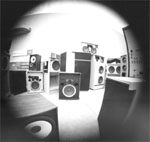I'm not sure what you're measuring... or what your -2dB is indicated on, so it
might be worth confirming a few things:
http://www.apicsllc.com/apics/Misc/filter2.html ... go to the bottom and plug in
driver impedance (in this case, use "8", as that's the L-pad you're using) and
"2" as the attenuation; with the l-pad knob set to "-2" you should be able to
measure R1 between the Lpad input and speaker output, and R2 between the
speaker output and ground/common, with nothing else attached.
...but the point of an L-pad is to approximate a consistent load as viewed by
the circuit upstream, while being able to vary the attenuation as seen at the output.
If you use an L-pad that isn't roughly close to the speaker load (or speaker plus
resistor load), the impedance seen by the upstream circuit (L-pad plus speaker)
will change with attenuation, and in a passive crossover, also affect the frequency
response. Dropping the 20 ohm resistor and finding a single optimized setting
for the 8ohm L-pad (attenuation - and parallel resistance) was just lucky.
If the upstream circuit is expecting the parallel load of 20ohms plus driver
(or a nominal 7.5 ohms if you make the -assumption- of a 12ohm driver), then
inserting an 8ohm L-pad seems appropriate. In setting up the 3133A network
though, JBL decided to use a 16ohm L-pad, so perhaps the 12ohm assumption
isn't the best. Do you have an impedance plot of an LE85/2420 on the horn
you're using? If not, I think I can set one up at home this weekend (no lens though).





 Reply With Quote
Reply With Quote
 ) on the changes in the sonic signature which others have encountered using the longer HL92/2312.
) on the changes in the sonic signature which others have encountered using the longer HL92/2312.  ) and enjoyable sound, however we do tend to report on the subjective effects of changes to our systems and seek improvements over time.
) and enjoyable sound, however we do tend to report on the subjective effects of changes to our systems and seek improvements over time.  .
.







 . I forgot to include Rload in the calculation of the attenuation. Now I get -4.25dB which makes much more sense. The load impedances seen by the network still work out pretty much as per my first calculations. My horn has the lens and sits on a baffle.
. I forgot to include Rload in the calculation of the attenuation. Now I get -4.25dB which makes much more sense. The load impedances seen by the network still work out pretty much as per my first calculations. My horn has the lens and sits on a baffle.
